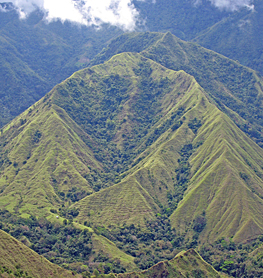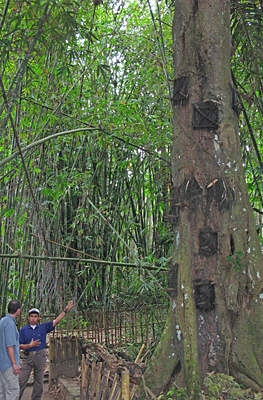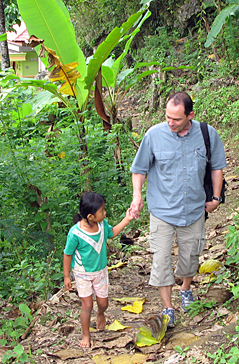It took us most of the day to get from Makassar, the provincial capital of South Sulawesi, to Rantepao in the Land of the Heavenly Kings, Tana Toraja, in the highlands. The trip had been very picturesque, though. Through beautiful but flat landscapes with rice fields and fish ponds with a view to the Makassar Strait on one side and rugged limestone mountains on the right. Then inland from Parepare across the peninsular and through some amazing mountainous scenery.

Along the way we were treated to an intricate royal rice dance performed by young boys accompanied by an electrified flute player on acid – or so it seemed. And we had our coffee at Bamba Puang overlooking Gonung Nona, literally Girl Mountain, but that's not jazzy enough to lure tourists to the region so we know it as Erotic Mountain.
Finally, at 6 pm we reached the Marante Highland Resort, which turned out to be a really classy place with swimming pool, a welcome massage and a large and tasty grill buffet. And loads of loudly quacking frogs and noisy cicadas but we were too tired to take any note of that.
The old religion
The origins of the Torajans are rooted in the regions of present-day Laos/Vietnam/China. The same origins as the Dayaks of East Kalimantan and the Bataks of North Sumatra. Another common denominator is that Christianity is the main religion of choice though mixed with a healthy dose of more or less animistic beliefs – or Aluk todolo, old religion, as they call it. Nowhere is this more evident than in Tana Toraja, although nowadays only about five percent are still believed to be true animists.
The village of Lemo lies on a plain of rice fields surrounded by steep cliffs. Here they used to bury their dead by cutting out burial chambers in the rock and putting up effigies of the dead on carved balconies. In Tampangalo they placed their wooden coffins in open caverns and grottos.

The child in the tree
Still in use by people of Aluk todolo are the trees of the dead children. When a baby or a small child dies a hole is carved in a special tree, the tiny body is placed inside and the hole is sealed with a wooden plate. As the tree grows the child becomes one with the tree, and it is hoped that the next child born will be as strong as the tree.
Hanging graves
Ke'te Kesu is the oldest village in Tana Toraja from about 6th century. Of course, nothing is left of the original houses but the houses today are about 80-90 years old and maintained on a regular basis. There are strong similarities to the shapes and building techniques of the Batak people of Sumatra. Ket'e Kesu also holds a good deal of so-called hanging graves where the coffin is placed on two girders sticking out from the cliff.


The last breath
When someone dies family members start to collect and save money for the burial ceremony. The more high-up, the more expensive the ceremony is expected to be. It is not uncommon to spend a couple of years saving up for a funeral. During this time the deceased stays in his house as usual. His family sees to it that he gets up in the morning, gets dressed, neighbours come by for a cup of coffee and a chat. For he is not seen as dead – merely ill.
The body is wrapped in special leaves from the forest to prevent smell and to facilitate mummification though nowadays a shot of formaldehyde usually does the trick. To have a dead person in the house would bring bad luck.

Rambu solo
A burial ceremony typically lasts 4-5 days and we were lucky to catch the rambu solo, the second day of the ceremony for a local dignitary at the village of Sangalla. Make no mistake. A burial is a celebration and a feast to pay respects to the deceased. Long queues of relatives, friends and officials from near and afar waited patiently to present gifts in the form of palm wine, rice and other foods as well as live pigs carried in not too comfortable bamboo contraptions. This is not for kids and animal lovers.
We witnessed a fascinating display of different dances, songs and musical entertainment by women and men in colourful dresses. And a flow of food and palm wine that seemed unstoppable.
A funeral may easily amount to 400 million Rupiah (about 28,000 Euro) in the form of buffalos to slaughter, temporary bamboo housing for the guests, undertaker, butcher, entertainment, burial site, etc. etc. etc. which is a lot of money in this part of the world. A specific number of buffalos is to be slaughtered depending on one’s status in the community.
At this funeral an estimated 10 buffalos at 20 million Rupiah and an unaccountable number of pigs were led to the slaughter to ensure that everybody had enough to eat. A thrilling day but, oh, the quacking of the frogs…

Back in Makassar
Back in Makassar we stayed in China Town in the wonderful gardens of the Hotel Pantai Gapura down by the harbour. Stops along the way included quite a large local market in Suda to get some salek a.k.a. snake skin fruit and the ever looming Girl Mountain.
Sir Stamford Raffles lived six years in Makassar and tried very hard to convince the local authorities to make the city the centre of all trade in Southeast Asia. But in the end the Dutch threw him out and he moved to the southern most tip of the Malaya Peninsula.
